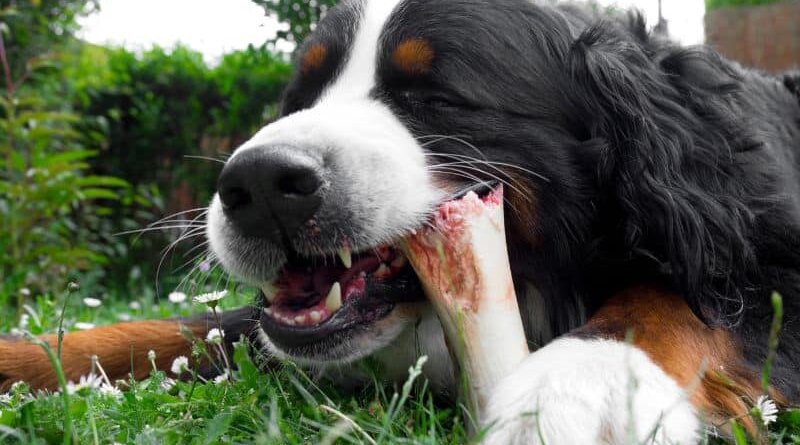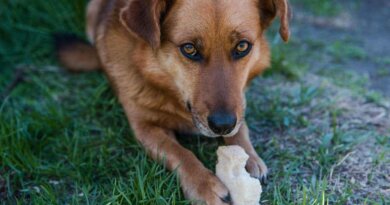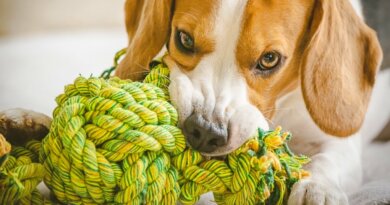Why Do Dogs Like Chewing On Bones?
This post may contain affiliate links. We may earn money or products from the companies mentioned in this post.
Snoopy, the beloved Beagle from the Peanuts comic strip, is a wonderful example of the innate love that dogs have for chewing on bones.
In his animated adventures, you can clearly see the joy and satisfaction dogs derive from sinking their teeth into a bone. But why do dogs like chewing on bones?
One specific example I’m thinking of is where Snoopy’s sitting on his doghouse reading a paper while eating a stack of bones, piled up as high as his doghouse.
Of course this is an exaggerated example of how many bones a dog can and would consume in one sitting – or is it?!
But all jokes aside, what stands out to me is the relaxing effect it seems to have on him.
As a matter of fact, my personal dogs as well as my client dogs all experience(d) similar effects whenever they go to town on a bone.
So in this blog post, we’ll look at:
- Why bones are the key to many doggie hearts
- Safe bones for dogs
- Fun bone alternatives
Ready? Let’s dive right in!
The Natural Inclination For Chewing in Dogs
As you may know, dogs trace their ancestral roots back to their wild counterparts, wolves.
These canines are skilled hunters and resourceful scavengers who rely on their instincts and physical prowess to survive.
That said, their strong jaws and sharp teeth are essential tools for tearing into the flesh of their captured prey.
This predatory nature is still embedded deep within the DNA of modern-day dogs, which contributes to their natural inclination for chewing.
By the way, did you know that dogs and wolves share 99.2% of the same DNA?
Yep, that includes cute little Shih-Tzus just as much as it does giant breeds like Great Danes!
I thought that was fascinating information when I stumbled over it in the raw dog food nutrition class I took from Dog Naturally Magazine (DNM University).
Raw Bones Fulfill Nutritional Needs In Dogs
However, it’s important to understand that wolves are not only hunters but also opportunistic scavengers.
That means that they have the ability to scavenge on carcasses and utilize all parts of an animal.
Since raw bones are rich in nutrients like calcium, phosphorus and fatty acids that are essential for their health, they’re an integral part of the wolf diet.
Calcium, for example, is a mineral that contributes to bone formation and density. It’s necessary for proper muscle function, blood clotting, and nerve transmission.
Phosphorus, on the other hand, is integral to energy metabolism, cell structure, and the formation of DNA and RNA.
In that respect, chewing on (raw) bones allows wolves to access valuable resources that are otherwise difficult to obtain.
And the same applies to our pet dogs who are fed a raw dog food diet.
As a raw feeder myself, I’m aware of the importance of raw meaty bones (RMBs) as an integral component of balanced raw dog food.
RMBs I’ve fed over the years are chicken leg quarters, duck frames, rabbit heads and pork trotters to name just a few.
Now, I understand that many people aren’t comfortable with the concept of feeding their dogs raw bones and that’s OK, I didn’t write this blog post to convince them otherwise.
I just want to point out that raw bones are safe for dogs to consume because they’re pliable and soft.
However, once bones are cooked, their density changes and they become brittle and can splinter. In that state, they can cause damage inside your dog’s body.
So where does that leave kibble-fed dogs or those that eat cooked dog food?
Well, the answer lies mostly in recreational bones.
But before I mention a variety of safe bones for dogs to chew on, let me touch on a few more reasons why dogs like chewing on bones!
The Physical and Mental Benefits of Chewing On Bones
Dogs also like chewing on bones because it provides mental stimulation and fights off boredom as well as anxiety!
While our pet dogs (mostly) don’t have to worry about social conflicts within their pack or scarcity of prey, they’re exposed to different stressors in their lives.
For example, a sedentary life that doesn’t drain them enough of their energy, separation anxiety, fireworks or construction work right outside their home.
Whatever their stressor may be, the repetitive motion of chewing is soothing for dogs and helps them relax.
Bonus: Chewing is also physical exercise for a dog’s jaws and neck muscles, helps keep their teeth clean and massages their gums.
That makes chewing an important lifelong activity for dogs from puppyhood through their golden years.
But rather than having your dog chew on furniture, shoes or other inappropriate items, you’ll want to make an effort to provide them with safe chewing alternatives.
Types Of Recreational Bones That Are NOT Safe For Dogs
That said, let’s start with a few bones you should steer clear from.
I strongly suggest you don’t offer your pup(py) bleached rawhide bones as they’re heavily infused with chemicals, not digestible and known for causing obstructions.
Likewise, I’m not a big fan of nylon bones because they’re not digestible given they’re made of nylon, a synthetic material.
Several of my pet sitting clients stopped giving their pups nylon bones when they found bits of nylon pieces in their #2.
Also, do yourself and your wallet a favor and don’t buy your pups those large smoked beef or bison bones you can find at grocery stores.
Yes, they look like every dog’s dream and can last a long time, but they can also break dog teeth in a heartbeat.
Before I became knowledgeable in raw feeding and began to feed my dogs accordingly, I made the mistake of accepting smoked beef bone gifts for my dogs from my neighbor.
She meant no harm at all and I didn’t know any better, but sure enough, my 75 lb Boxer mix Buzz broke one of his upper molars while chewing on the darn thing!
Not only was it painful for him, it was also expensive because he had to have surgery at the vet’s to have the entire tooth extracted.
Unfortunately, that was the only option as the pulp was exposed. That’s the nerve and blood supply of the tooth.
Now, I’m not saying that your dog WILL break a tooth as only Buzz did and his sister Missy didn’t, but there’s a 50:50 chance.
Elk & Deer Antlers For Dogs
The only other real bone that’s safe-ish for dogs to chew and consume are elk antlers and deer antlers.
They consist of fully digestible bone and marrow and are a natural product without added chemicals, preservatives, or artificial flavors.
While they’re tough and long lasting, I’ll throw in a word of caution and say that whole elk antlers may not be the right fit for aggressive chewers as they can risk dental fractures like the one that happened to Buzz.
That said, whole deer antlers are much softer than elk antlers given that deer are smaller than elk and have a lesser mineral content.
So for aggressive chewers, whole deer antlers or split elk antlers are a safer option.
Split antlers also work nicely for picky eaters since the marrow is already exposed when you offer them the chew.
After Buzz’s tooth fracture incident, I replaced their whole antlers with split antlers and never had another issue.
And while my pup Wally loves his raw meaty bones, he couldn’t care less for whole antlers but will eat the split kind!
Other Safe Alternatives To Bones For Dogs
Thankfully, there are several good alternatives to bones for dogs that are just as mentally stimulating, and I’ll list them from toughest to softest.
Single-Ingredient Cow Hooves for Dogs
While cow hooves are also a hard chew, they’re not quite as hard as antlers since they don’t consist of bone but mostly of keratin, a tough and fibrous protein.
That said, they’re a great dog chew for normal chewers but again may not be the best option for power chewers.
But there’s a workaround!
While you can’t split a cow hoof in half, you can stuff and freeze it with yummy fillers like peanut butter, pumpkin puree or yogurt.
That way, you can offer the frozen hoof to your aggressive chewer and then take it away once they’ve emptied it.
That’s how Buzz got to eat them, and my current pup Wally eats them like that as well.
Granted, that turns them into a frozen treat rather than a chew, but it still keeps them busy.
Just like antlers, cow hooves are a natural dog chew that doesn’t contain any artificial ingredients.
Limited-Ingredient Himalayan Chews for Dogs
Himalayan chews are also a hard chew but nowhere near as hard as antlers and cow hooves.
They’re typically made from a mixture of yak milk, cow milk, and a small amount of lime juice as well as a pinch of salt used as a natural preservative.
Although they’re made with milk, most of the lactose is removed during the production process, which makes them a good choice even for dogs with lactose intolerance.
Here’s how they’re made:
The milk is boiled, strained, and then allowed to cool and separate. The solid portion is compressed and sun-dried to create the hardened cheese chew.
All of my pups had them and never had any trouble with them.
Single-Ingredient Bully Sticks
Bully sticks are almost as hard as Yak chews but overall a bit softer.
They’re made from the protein-rich penis of a bull or a steer and are a doggie favorite that comes in different lengths and thicknesses.
That way, they work great for all types of chewers.
While bully sticks don’t just lie around waiting to be picked up like antlers, they’re typically sourced from the meat industry as a byproduct.
Here’s how they’re made:
The penises of bulls or steers are collected during the animal’s processing for meat production and are then cleaned, dried and packaged.
Tip: You can stick them into what’s known as a bully stick holder to make them last longer!
They definitely have been and continue to be my number one choice to keep all of my dogs entertained when I’m in virtual work meetings.
Single-Ingredient Pig Ears
Pig ears are much softer than the previous chews I mentioned, which is why they won’t last quite as long as the other options.
However, they still make a great fully edible snack for puppies, normal chewers and senior pups.
They either come as whole pig ears or as sliced half pig ears, which can be great if you’re looking for a chew for toy breeds and puppies.
Similar to bully sticks, they’re collected when pigs are processed for meat and then cleaned, dried and packaged.
They were and continue to be a hit with all of my pups!
Click here to learn more about pig ears for dogs.
Single-Ingredient Chicken Feet & Duck Feet
Chicken feet and duck feet are the softest, smallest dog chews on this list and are really more of a snack for large dogs.
But it makes wonderful single-ingredient chews for small dogs, puppies and those who aren’t power chewers.
They’re also collected when chickens and ducks are processed for meat followed by cleaning, drying and packaging them.
My pups Missy and Buzz loved them although they were bigger pups, but since they didn’t gulp them down, I felt comfortable offering them both chicken and duck feet.
My pup Wally can only have duck feet because of his chicken allergy, so that’s something to keep in mind if you have a dog with a known food sensitivity.
Bottom Line
As a recap, the primal activity of chewing on bones not only satisfies a dog’s natural instincts, it also provides them with:
- Physical exercise for their jaws and neck muscles
- Valuable nutrients found in raw meaty bones
- Mental stimulation
- Oral benefits
Remember to avoid cooked bones that are likely to splinter, smoked beef bones that can break a tooth, as well as those that aren’t digestible such as rawhide and nylon bones.
Instead, opt for safer dog bone alternatives like antlers, hooves, Yak chews, bully sticks, pig ears and chicken or duck feet.
I personally find the ancestral connection to wolves extremely helpful in understanding why dogs like chewing on bones so much!
How about you?
Save To Pinterest
Top Picks For Our Puppies
- BEST PUPPY TOY
We Like: Calmeroos Puppy Toy w/ Heartbeat and Heat Packs – Perfect for new puppies. Helps ease anxiety in their new home. - BEST DOG CHEW
We Like: Mighty Paw Naturals Bully Sticks – All of our puppies love to bite, nip, and chew. We love using Bully Sticks to help divert these unwanted behaviors. - BEST DOG TREATS
We Like: Crazy Dog Train-Me Treats – We use these as our high-value treats for our guide dog puppies. - BEST FRESH DOG FOOD
We Like: The Farmer’s Dog – A couple months ago we started feeding Raven fresh dog food and she loves it! Get 50% off your first order of The Farmer’s Dog.
Check out more of our favorites on our New Puppy Checklist.




